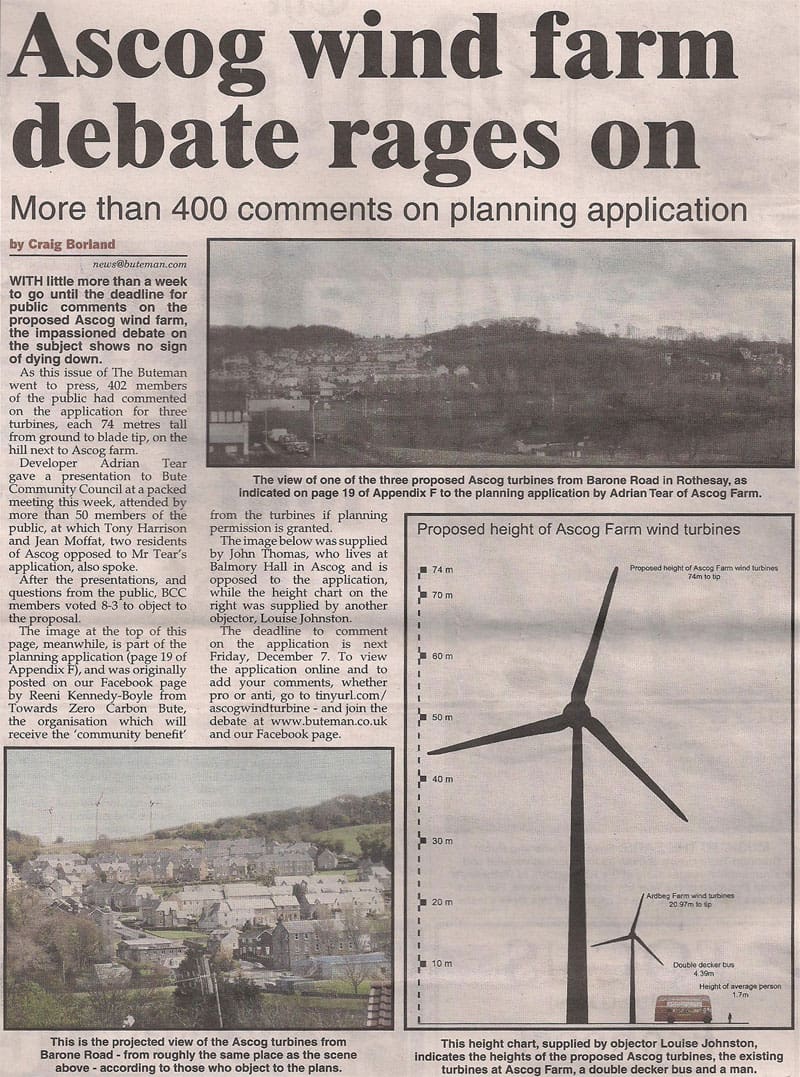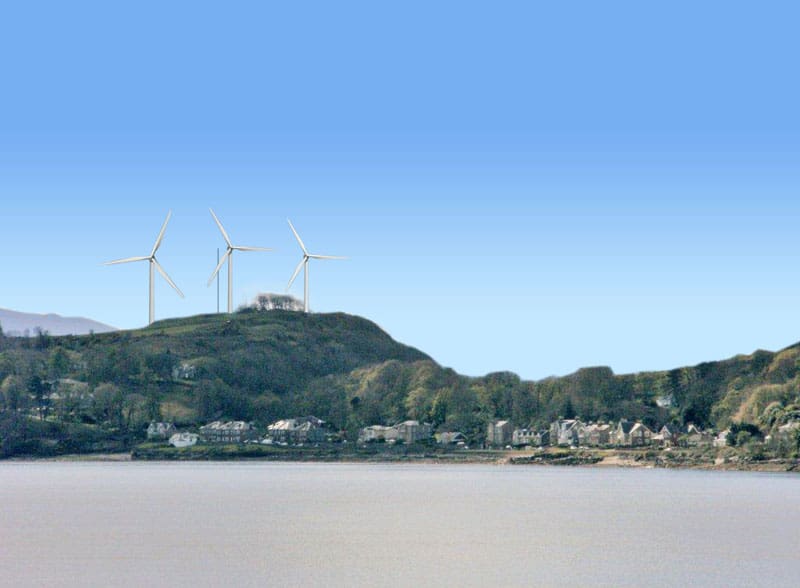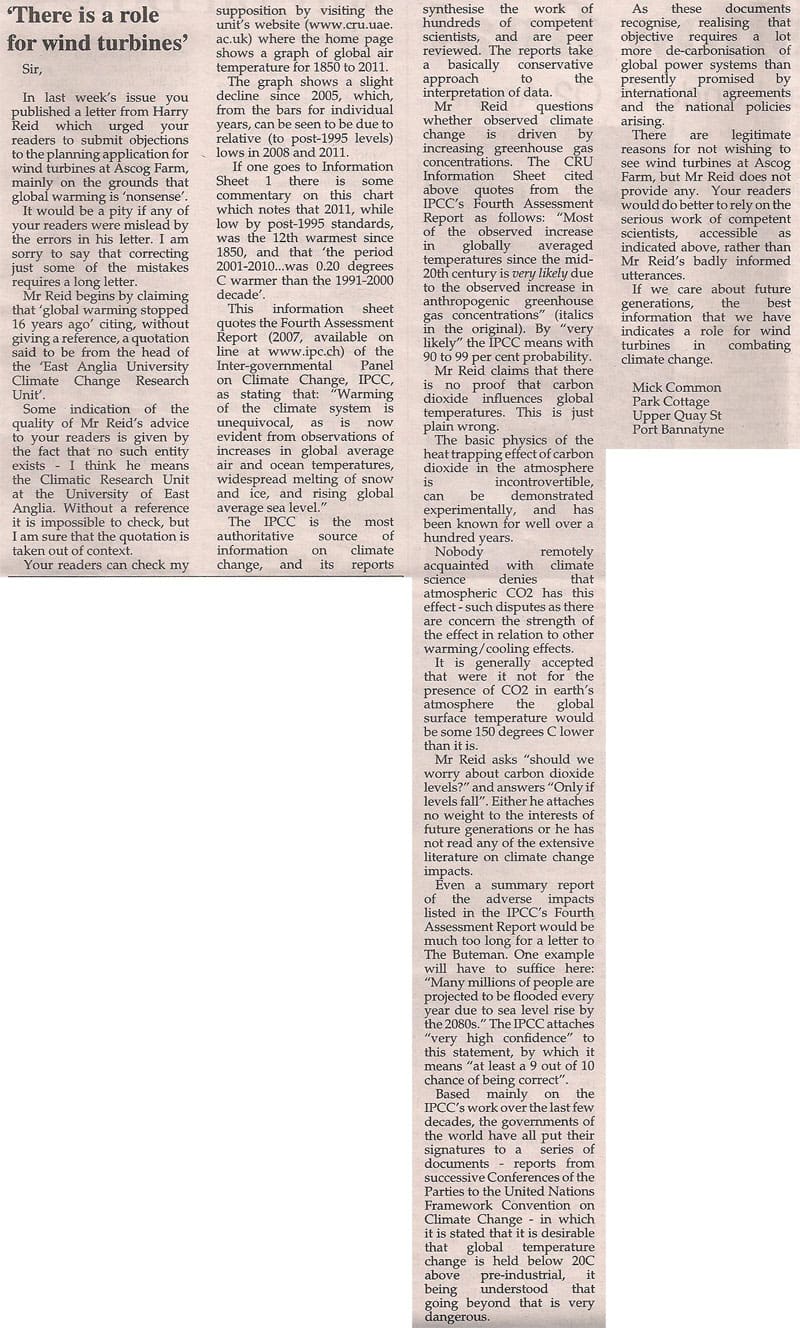It’s an interesting week in The Buteman this week as more editorial coverage and letters continue to ‘rage on’ about the wind energy debate and one letter writer suggests there is ‘a strong possibility of a civil disobedience campaign to stop [the Ascog Farm planning application]’.
Let’s examine the content in more detail…
News and Editorial
Following last week’s bumper wind edition we are not on the front page of The Buteman this week, although we are on page 2.
Anti-wind campaigners Mr John Thomas (Balmory Hall, Ascog) and Mrs Louise Johnston (Millburn, Ascog) have both sent drawings in to the paper!

©The Buteman
Mr Thomas’s drawing is a repeat of an earlier ‘photomontage’ created by an unknown ‘concerned resident’. The inaccuracy of this particular ‘photomontage’ has been detailed previously in our article ‘The campaign of misinformation gathers pace’ and we, as well as other members of the public, have alerted Argyll & Bute Council’s planning department to the existence of these highly inaccurate renderings which have been pinned up in pubs or circulated around Bute (and/or the Internet) for months.
By way of example, another inaccurate photomontage (‘taken’ from offshore where nobody lives!) is reproduced below. It does not show the sort of panoramic view taken in by the eye and appears closely ‘zoomed’ above the Montford area:

Another inaccurate anti-wind campaign ‘photomontage’
This graphic has been doing the rounds within emails, at least one of which has come to our attention, circulated to dozens of people.
Of course, not everyone likes the look of wind turbines. However, one has to wonder if those drumming up widespread objections to the application are shooting themselves in the foot?
-
Are the apparently ‘destructive’ effects on tourism clear cut?
The recent Scottish Parliament Economy, Energy and Tourism Committee ‘Report on the achievability of the Scottish Government’s renewable energy targets’ states (para 283, p55) that ‘Whilst care always needs to be taken in terms of the planning process and decisions on the siting of individual projects in areas popular with tourists and in our more rural and remote rural areas, no witness has provided the Committee with robust, empirical evidence, as opposed to anecdotal comment and opinion, that tourism is being negatively affected by the development of renewable projects.’ Some may point to a recent ‘Attitudes to turbines’ poll conducted by YouGov for the John Muir Trust which has found that ’43 per cent of people in Britain who visit scenic areas in the UK for their natural heritage and beauty would be ‘less likely to visit a scenic area with a large concentration of wind farms’’. However, over 30 wind turbines are already visible from Bute (with a further four on Bute) and the John Muir Trust ‘opposes inappropriate development on important areas of wild land in the UK – that is, large areas of high scenic and wildlife value, with minimal evidence of modern human development’. Bute does have several areas of high scenic value but it is hard to argue that it is ‘wild land’ with ‘minimal evidence of modern human development’. If turbines are to be sited miles away from where anyone lives simply so people do not have to look at them the few areas of truly ‘wild land’ left in Britain will not be wild for much longer! -
Are the ‘noise’ or ‘health’ effects of wind turbines over-played?
Newspapers such as The Daily Mail and The Daily Telegraph have been keen to pick up on and promote claims of a ‘Wind Turbine Syndrome’ that have not been found in the scientific literature. Claims of ‘infrasound’ or ‘low frequency noise’ prompting all sorts of ailments have been made repeatedly in letters to The Buteman. Dr Geoff Leventhall, Consultant in Noise Vibration and Acoustics, has dismissed claims of health effects arising from ‘infrasound’ stating that ‘infrasound and inaudible noise from wind turbines are not a health problem’. Attitudes to noise sources, as Dr Leventhall notes, are more likey to be a large factor in the degree of perceived annoyance. We are likely to see a lot more wind turbines everywhere as the world’s governments seek to ‘decarbonise’ our energy systems. Perhaps we should just learn to live with them? People on other Scottish Islands such as Gigha and Lewis already do, and there have not been any reports of bizarre health problems from those places. -
Will there really be no benefits for those living on Bute?
A defining characteristic of our application is that we have been working with Community Energy Scotland, who are administering the Scottish Government’s Community and Renewable Energy Scheme (CARES) which is explicitly designed to maximise the benefits of renewables projects to local communities. Where a large National or International energy company would normally take the risk on the planning application, lease farmland (benefiting the landowner) and make payments to the community of around £2,000/mW installed capacity/year (whilst making off with all the generating income!) we will make payments of £10,000/mW installed capacity/year OR 20% of net profit/year (whichever is the greater). We also intend to use as many local contractors as possible in the building phase – if permission is granted – and, where possible, for ongoing maintenance. We take the risk, and a large loan, on the £3.5 million projected capital expenditure costs and hope that as the loan is repaid and the project moves into profitability income from electricity sales leads to on-farm diversification, improvements (involving further investment) and community benefit payments. All of the above are designed to keep the money as ‘local’ as possible and to maximise the potential of creating work and, hopefully, employment. This could be important, since tourism has been in long-term decline on Bute since the 1950s.
Returning to the photomontage so widely distributed by anti-wind campaigners (some other notable examples of locally produced anti-wind web-based research and graphics are available here (3.2MB PDF)) our consultants at the Scottish Agricultural College, responsible for overseeing the detailed and factual preparation of the Environmental Impact Assessment into the wind energy project (2.9MB PDF) have written to the Argyll & Bute planning officers as follows:
|
Hi Steven
I trust that you are well. In response to your email below regarding the photomontage from a vantage point on the route of the Caledonian MacBrayne Ferry from Wemyss Bay to Rothesay, please see our comments below. Unfortunately we are unable to generate an accurate photomontage from the same viewpoint as the one that has been submitted [in the] letter due to the following constraints:
As regards the photomontage, the turbine layout and close spacing is an inaccurate reflection of the proposed Ascog development which is highlighted in Viewpoint 3 submitted in the technical appendices and attached here. Essentially the turbines in the photomontage are shown as a tight cluster rather than an evenly spaced array. Finally the turbines that have been used to produce this visualisation appear to be of a different scale than the turbines proposed at Ascog. The Ascog Turbines have a rotor diameter equivalent to 64% of the total height of the turbine whereas the turbines used in the submitted photomontage appear to have a rotor diameter that would be equivalent to 80% of the total turbine height. Overall, the turbines in the submitted photomontage appear to be larger in scale than the proposed 74 m high Ascog turbines. Therefore in summary, the submitted photomontage is not considered to be a technically accurate or realistic impression of the proposed Ascog Development. Regards etc |
Mrs Louise Johnston’s drawing for The Buteman (incorporating a person, bus, Ardbeg turbines and proposed Ascog turbines) looks a bit more accurate in terms of size comparison but, unfortunately, does not take into account setting and visibility which will vary from place to place on or around Bute.
A great deal of time was spent in consultation with Scottish Natural Heritage determining the set of viewpoints by which the Landscape and Visual Impact Assessment of the proposed scheme should be judged. As far as we know the landscape experts (AMEC) did what they were asked (albeit in a year characterised by challenging weather conditions for clear photography) and these documents are all available from this web site.
Thankfully, some qualified planners will be looking into the application and we will work with them to see what, if anything, can be built on our windy hill top site.
Letters
Of course, whilst some news reports have appeared in The Buteman, it would be a strange week indeed if there were not also some Letters to the Editor.
Last week’s edition was a real bonanza but this week we are treated only to two. In fairness to the authors these are covered in the order in which they were printed.
First up Mr Mick Common of Park Cottage, Port Bannatyne with a letter titled ‘There is a role for wind turbines’

©The Buteman
Mr Common references last week’s letter from Mr Harry Reid in which a confident assertion was made that ‘Global warming stopped 16 years ago in 1996.’
Like us, Mr Common finds this rather hard to believe.
Secondly, there is a curious letter from Mr Norman Lamond of Crichton Road, Rothesay.

©The Buteman
In his letter Mr Lamond suggests that ‘there has to be a strong possibility of a civil disobedience campaign to stop what most people consider a disaster in this particular spot.’
There is a long tradition of civil disobedience in Britain and it is up to the authorities to deal with it.
We live in a civilised society in which people are able to make planning applications for development of assets they own. Whether these are accepted, rejected or accepted with amendments is a matter for the local planning authorities (and/or Scottish Ministers) and not some sort of mob rule.